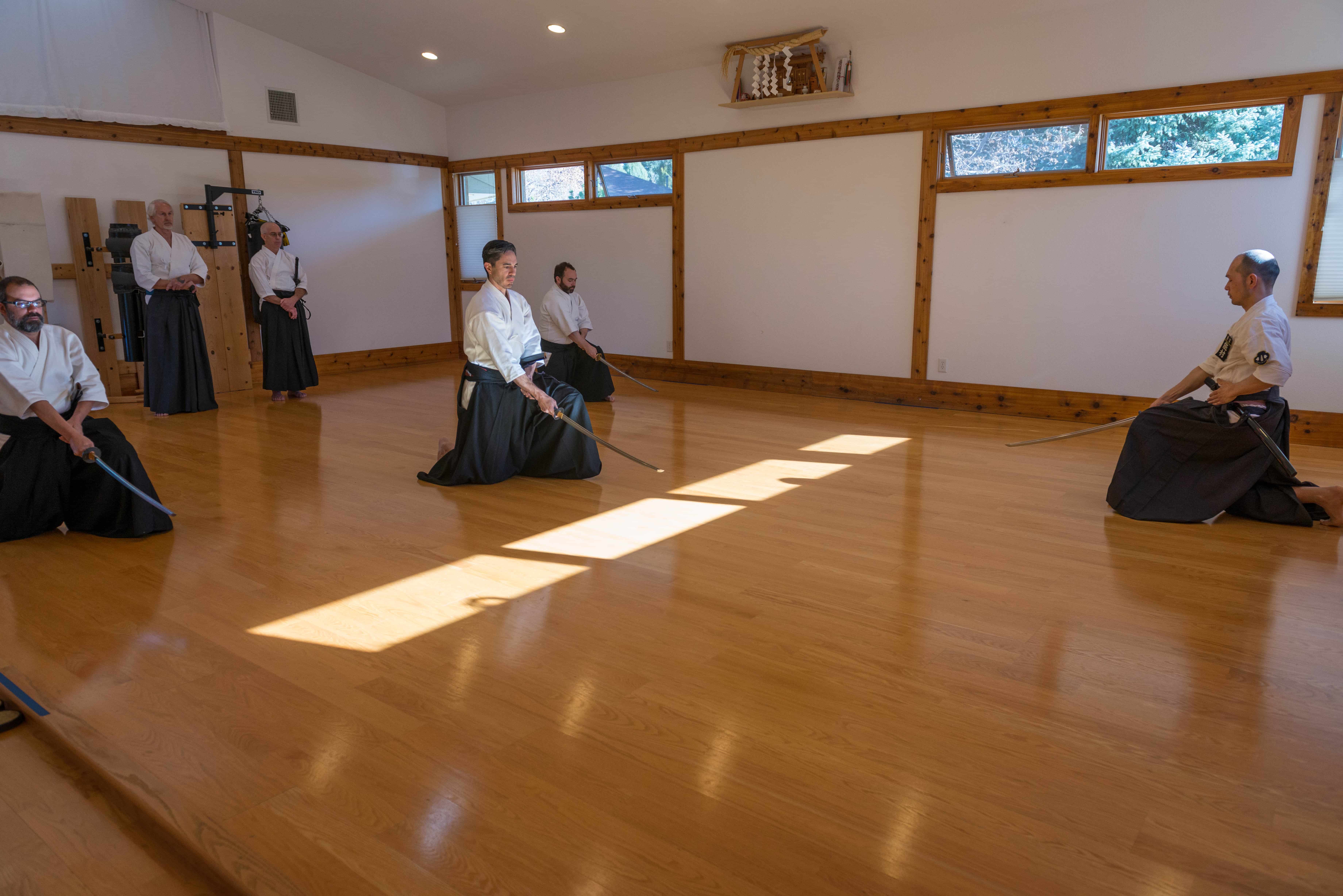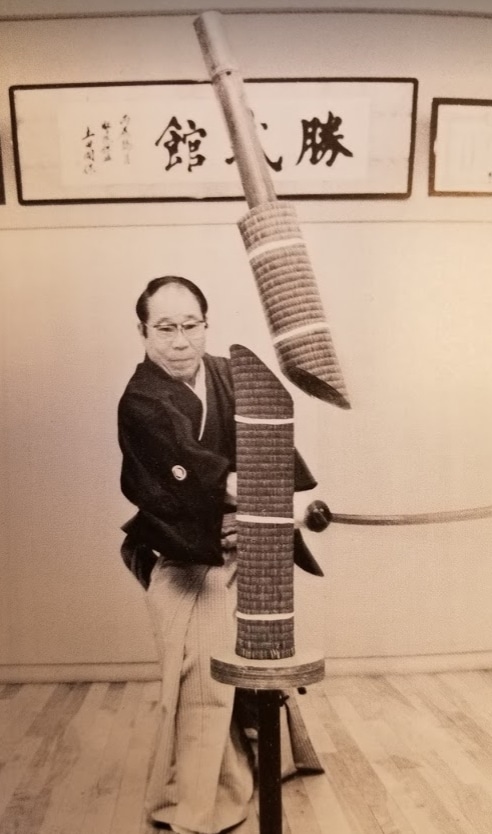MUSO JIKIDEN EISHIN RYU IAIDO
無雙直傳英信流居合道
About Iaido Iaido Kata & Kumitachi Our Lineage Related Dojo
* Note: Iaido training is full at this time, with no spaces available *
* Note: Iaido training is full at this time, with no spaces available *
About Iaido
Iaido Kata & Kumitachi
Our Lineage
Related Dojo
About Iaido
Back to Top
Iaido is the Japanese martial art of drawing the sword and cutting in a single motion. Iaido, as we know it today, originated almost 450 years ago in the Sengoku period of Japan, a time of constant wars. The originator, Jinsuke Shigenobu, formed the style that eventually became known as ‘Muso Jikiden Eishin Ryu’ ( 無雙直傳英信流居合道 ), which was based upon his wartime experiences.
Since that time, several related styles of Iaido have formed, but many which remain are based upon Muso Jikiden Eishin ryu (commonly called ‘Eishin Ryu’), and retain the core teachings of this style. As time passed and Japan entered an era of extended peace during the Tokugawa period, those who studied Iaido and many other martial arts, sought to find their place in a changing world. The need for pure combat efficiency took on a smaller role, and the desire to define purpose and meaning for the austere training methods of the martial arts gained importance.
Today, Iaido training is primarily a vehicle for personal development. Iaido training is based on ‘kata’ and ‘kumitachi.’ Kata are prearranged practice forms done by one person, and kumitachi are performed in pairs. Kata and Kumitachi are the repository of the original combat strategies. Iaido training methods require intense mental and physical concentration. Repeating these forms, very precisely, over many years, provides a vehicle for physical and personal development, and a chance for students to better understand themselves and their place in the modern world.
Our affiliation is with the Nichirei Dojo near Ishikawa-dai station in southwest Tokyo, founded by Furuoka Masaru (Nittosai). We studied directly under Furuoka Masaru for many years. After his passing in 2006 his son, Furuoka Takashi Sensei, became the current headmaster of this line of Muso Jikiden Eishin ryu (see ‘Our Lineage’ below).
Furuoka M. Sensei also developed a modern variation of Iaido, called Hiken Muso ryu Iaigiri-do, with strong emphasis on tameshigiri as an integral component of training.

Furuoka Sensei at Gakken Dojo in southwest Tokyo [1]

About Iaido
Back to Top
Iaido is the Japanese martial art of drawing the sword and cutting in a single motion. Iaido, as we know it today, originated almost 450 years ago in the Sengoku period of Japan, a time of constant wars. The originator, Jinsuke Shigenobu, formed the style that eventually became known as ‘Muso Jikiden Eishin Ryu’ ( 無雙直傳英信流居合道 ), which was based upon his wartime experiences.
Since that time, several related styles of Iaido have formed, but many which remain are based upon Muso Jikiden Eishin ryu (commonly called ‘Eishin Ryu’), and retain the core teachings of this style.
As time passed and Japan entered an era of extended peace during the Tokugawa period, those who studied Iaido and many other martial arts, sought to find their place in a changing world. The need for pure combat efficiency took on a smaller role, and the desire to define purpose and meaning for the austere training methods of the martial arts gained importance.
Today, Iaido training is primarily a vehicle for personal development. Iaido training is based on ‘kata’ and ‘kumitachi.’ Kata are prearranged practice forms done by one person, and kumitachi are performed in pairs. Kata and Kumitachi are the repository of the original combat strategies.
Iaido training methods require intense mental and physical concentration. Repeating these forms, very precisely, over many years, provides a vehicle for physical and personal development, and a chance for students to better understand themselves and their place in the modern world.

Our affiliation is with the Nichirei Dojo near Ishikawa-dai station in southwest Tokyo, founded by Furuoka Masaru (Nittosai). We studied directly under Furuoka Masaru for many years. After his passing in 2006 his son, Furuoka Takashi Sensei, became the current headmaster of this line of Muso Jikiden Eishin ryu (see ‘Our Lineage’ below).
Furuoka M. Sensei also developed a modern variation of Iaido, called Hiken Muso ryu Iaigiri-do, with strong emphasis on tameshigiri as an integral component of training.

Furuoka Sensei at Gakken Dojo in southwest Tokyo [1]
Iaido Kata (solo) & Kumitachi (paired)
Back to Top
Eishin Ryu Iaido has several groups of kata (solo practice) and kumitachi (paired practice) that gradually take a student from basic to advanced use of the Japanese sword. Progression is step-wise, starting from ‘seiza’ (a seated position) to standing. Generally the solo kata is taught first, then the kumitachi is added once the student has a good grasp of the basics.
Training is with shinken and bokuto. In this school/dojo we do not use an iaito or moguito (unsharp practice sword) that is common in most, but not all, Iaido schools today.
While using a shinken (real Japanese sword) may sound dangerous… yes it can be. We do not take this training method lightly, and initial lessons are taught slowly and carefully. In fact most Iaido is practiced slowly as a general rule.
Use Youtube to view an Eishin ryu demonstration vs. a Katori Shinto Ryu demonstration. You will see very different speeds of training, with Iaido being performed relatively much slower. Slower equals a very careful learning process designed to maximinze safety with the given weapon.
The benefits of properly learning to use a Japanese sword/shinken from the onset of one’s training reduces dangerous and counter productive habits that can occur when using an iaito (unsharpened practice sword).
The belief is that the proper mindset, concentration, and swordsmanship skills produced by learning to use a real sword is of critical importance.
1. Seiza no Bu
正座之部
| 前 | Mae |
| 右 | Migi |
| 左 | Hidari |
| 後 | Ushiro |
| 八重垣 | Yae Gakki |
| 受流 | Uke Nagashi |
| 介錯 | Kai Shaku |
| 附込 | Tsuke Komi |
| 月影 | Tsuki Kage |
| 追風 | Oi Kaze |
| 抜打 | Nuki Uchi |
2. Tate Hiza no Bu
立膝之部
| 横雲 | Yoko Gumo |
| 虎一足 | Tora Issoku |
| 稲妻 | Inazuma |
| 浮雲 | Uki Gumo |
| 颪 | Oroshi |
| 岩波 | Iwa Nami |
| 鱗返 | Uroko Gaeshi |
| 波返 | Nami Gaeshi |
| 瀧落 | Taki Otoshi |
| 真向 | Makko |
3. Oku Iai Iwaza
奥居合居業之部
| 霞 | Kasumi |
| 脛囲 | Tsune Gakoi |
| 戸詰 | Tozume |
| 戸脇 | To Waki |
| 四方切 | Shiho Giri |
| 棚下 | Tanashita |
| 両詰 | Ryozume |
| 虎走 | Torabashiri |
| 抜打 | Nuki Uchi |
4. Oku Iai Tachi waza
奥居合立業
| 行連 | Yuki Zure |
| 連達 | Tsure Dachi |
| 惣捲 | So Makkuri |
| 惣留 | So Dome |
| 信夫 | Shinobu |
| 行違 | Yuki Chigai |
| 袖摺返 | Sode Zuri Gaeshi |
| 門入 | Mon 'Iri |
| 壁添 | Kabe Zoi |
| 受流 | Uke Nagashi |
| 暇乞其の 一, 二, 三 | Itto Magoi (3) |
5. Tachi Uchi no Kurai
太刀打之位
| 出合 | Deai |
| 拳取 | Kobushi Tori |
| 絶妙剣 | Zetsu Myoken |
| 独妙剣 | Doku Myoken |
| 鍔留 | Tsuba Dome |
| 請流 | Uke Nagashi |
| 真方 | Mappo |
| 水月刀 | Suigetsu To |
| 心明剣 | Shin Myoken |
| 月影 | Tsuki Kage |
6. Tsumeai no Kurai
詰合之位
| 発早 | Hasso |
| 拳取 | Kobushi Tori |
| 波返 | Nami Gaeshi |
| 八重垣 | Yae Gakki |
| 鱗返 | Uroko Gaeshi |
| 位弛 | Kurai Yurumi |
| 燕返 | Tsubame Gaeshi |
| 眼関落 | Ganseki Otoshi |
| 水月刀 | Suigetsu To |
| 霞剣 | Kasumi Ken |
Our Lineage
Back to Top
Eishin ryu Iaido traces its lineage back to Hayashizaki Shigenobu and the founding of Hayashizaki Shin Muso ryu. As this developed over time various headmasters added to, or reorganized the curriculum and changed the name(s).
Transmission was/is somewhat indiscriminate and allows for anyone who has received a menkyo kaiden (known as ‘Kongen no Maki’ in Eishin ryu) to further award licenses to any number of students. It is quite likely we do not know the full list of those having received this license.[2]
Nonetheless, Eishin ryu continues today along numerous lines of transmission. All of these lines, in the large picture, essentially study the same kata, or sets of kata. With each line having its own ‘flavor’ or emphasis. Watching these various lines perform kata, one can usually understand and clearly see the kata being performed.
This line of Eishin ryu uses the modern kyu/dan ranking system, from shodan/1 to hachidan/8 . The headmaster position is conferred full transmission of the art with the traditional license of ‘Kongen no Maki’.
Our line of study is under Hirai Agisai -> Furuoka Masaru of the Nichirei dojo in southeast Tokyo -> and now his son Furuoka Takashi.
Abridged lineage of Eishin Ryu
Hayashizaki Jinsuke Shigenobu – founder of Hayashizaki Shin Musō-ryū (林崎新夢想流)
Hasegawa Chikaranosuke Hidenobu (Eishin) – founder of Hasegawa Eishin-ryu (長谷川英信流)
Hayashi Rokudaya Morimasa
Shimomura-Ha
Shimomura Shigeichi
Nakayama Hiromichi (Hakudo) –
founder Muso Shinden Ryu
夢想神伝流
No clear successor today
Tanimura-ha
Tanimura Kamenojo Takakatsu
Goto Mogobei Masasuke
Oe Masamichi (Masaji) – founder of
Muso Jikiden Eishin Ryu 無雙直傳英信流
Numerous lines of transmission
Okiyama Namio
Fukui Harumasa
Kono Hakuren – numerous students with no clear successor
|
Hirai Agisai
Furuoka Masaru (Nittosai 1920-2006) – Furuoka Sensei also created a modern variant of Eishin ryu called ‘Hiken Muso Ryu’. With emphasis on tameshigiri based on Eishin ryu kata.

Furuoka Sensei at his Shobukan Dojo near Shinagawa, Tokyo [1]
Furuoka Takashi (b1946) current headmaster
|
Alternate Line
Fukui Torao
Related Dojo
Back to Top
USA – Shobukan Dojo | Foothills Budokai – Denver, Colorado, Torrance Budokai – Torrance, California,
Japan – Tokyo: Three(3) dojo near Ishikawadai station on the Tokyu-Ikegami line
Nichirei Dojo (primary), Yukitani Middle School, Okuzawa Junior High
References
1. Furuoka Nittosai, Hiken Muso Ryu Iaigiri, Gakken Publishing Co. 1983
2. Muso Jikiden Eishin Ryu
